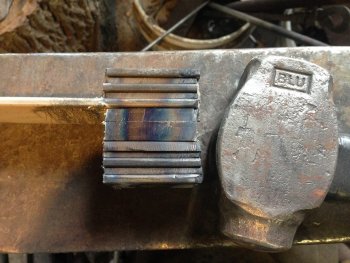There was a time in my career when I used to advise new folks to start out with cable, but over time I came to realize I was giving bad advice. Forge welding cable can be difficult for even experienced forgers. My advice is to start out with straight laminates. The key being to choose the steels you use wisely. Many times I have spoken of "compatability" when choosing steels to combine in damascus. Different steel types have different contraction and expansion rates when heated and cooled....the key in creating successful forge welds is to choose steels that offer good contrast in the finished product, but also have similar contraction and expansion characteristics. Right now, IMO, there is no better overall combination for damascus then 1080 and 15N20 steels. They are very similar in makeup, with the exception of 15N20's nickel content. They are very easy to forge weld, and because of the similarities, you can do things with this combination that many other combos simply will not tolerate.
Long story short....skip the cable, and use straight laminates....IF you want to have the best chances for success.



